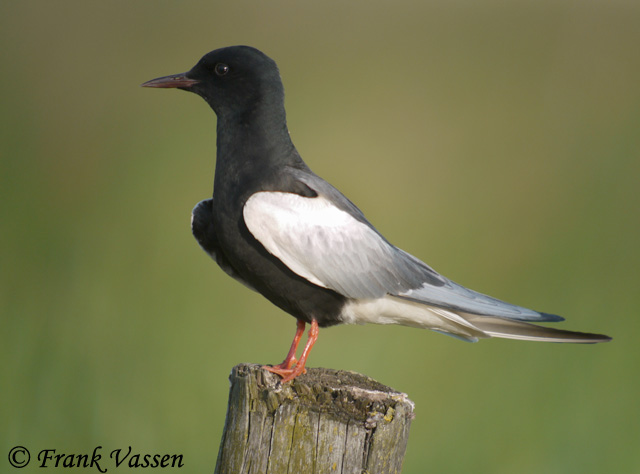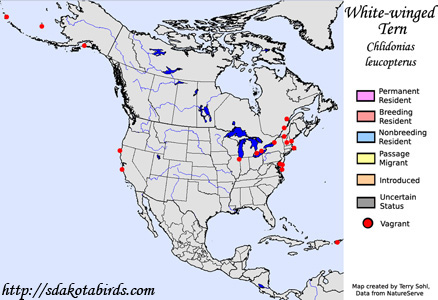| Length: 9.5 inches | Wingspan: 23 inches | Seasonality: Non-resident in South Dakota |
| ID Keys: Breeding plumage: black body, head, and neck, wings white above and dark below. Non-breeding birds white with gray wings, small amount of black on head. | ||
 The
White-winged Tern is a Eurasian species that is very similar to North
America's Black Tern. Here, they are
but rare vagrants, with most sightings occurring near the Great lakes and
along the north Atlantic Coast of the United States. When seen in
North America, they are typically found in flocks of Black Terns.
There is a record of a White-winged Tern breeding with a Black Tern in
Canada. Hybrids of the two species have also been noted in Europe.
The
White-winged Tern is a Eurasian species that is very similar to North
America's Black Tern. Here, they are
but rare vagrants, with most sightings occurring near the Great lakes and
along the north Atlantic Coast of the United States. When seen in
North America, they are typically found in flocks of Black Terns.
There is a record of a White-winged Tern breeding with a Black Tern in
Canada. Hybrids of the two species have also been noted in Europe.
Habitat: Found on freshwater wetlands and lakes during the summer breeding season. In winter and in migration, may be found in and around a variety of aquatic habitats, including coastal areas.
Diet: Mostly feeds on insects, but will also sometimes take other small food items such as amphibians and small fish.
Behavior: Foraging is done while in flight, with birds capturing insects in mid-air, dipping down to grab food items at the water's surface, or hovering while grabbing food items from the water's surface or wetland vegetation.
Nesting: Colonial nester, breeding in small colonies of up to 100 pairs. The nest of a White-winged Tern is a depression on a mound of wetland vegetation. The female lays 2 or 3 eggs.
Song: Has a short, harsh 'kek' call.
Migration: Breeding range is in central Europe through central Asia, and locally in eastern Asia. Winter range of the White-winged Tern includes Africa, the Middle East, India, Southeastern Asia, and the Australian region.
Interactive eBird Map: Click here to access an interactive eBird map of White-winged Tern sightings
Similar Species: Very similar to North America's Black Tern.
Conservation Status: Populations are very large, they are spread over a very wide geographic area, and they are common in parts of their range. The IUCN lists the White-winged Tern as a species of "Least Concern".
Further Information: 1) Australian Government - Department of Sustainability, Environment, Water, Population, and Communities - White-winged Tern
2) BirdLife International - White-winged Tern
3) AviBirds.com - White-winged Tern
Photo Information: Photo taken by Frank Vassen - May 21st, 2010 - Poland - Photo licensed under Creative Commons Attribution 2.0 Generic License.
| Click below for a higher-resolution map |
 |
| South Dakota Status: Non-resident in South Dakota |
Additional White-winged Tern Photos (coming soon!!)
